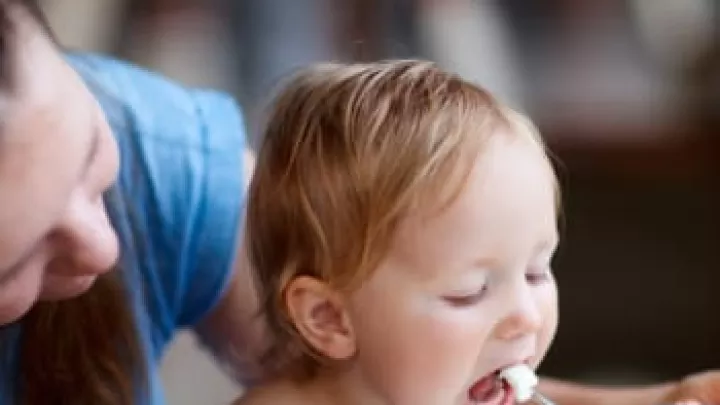
Feeding Tips for the Hospitalized Child
In earlier blogs I wrote about the care of Gastrostomy tubes for the tube-fed child and then collaborated with a colleague to address the issue of tummy time and how important it is to the growing baby. I am again teaming up with this colleague, Janae Grimshaw, an Occupational Therapist at our hospital, Children’s Hospital Los Angeles, who is a co-teacher in the gastrostomy tube class that we offer to parents. In this blog Janae and I will talk about tips for helping a child learn to eat.
There are many reasons a child might have difficulty eating such as:
- Recent esophageal surgery
- Gastroesophageal reflux or GERD
- Painful or traumatic experiences involving the mouth, nose, throat and esophagus.
Some of these children may try to avoid eating by arching, crying, coughing, turning away, squirming, retching or vomiting. This behavior may indicate the child cannot eat and may need therapy to learn how to eat or may need a G-tube. Some children who need G-tubes aren’t able to take any food by mouth, and will need to keep the tube in indefinitely to get the necessary nutrition to grow, develop and survive. Other children however will be able to learn how to eat. Each child is different. Therapists, like Janae, help to find out to what extent the child will be able to eat safely. For those who can eventually learn to eat, there are tips to help them through the process.
Eating is a Social Event
Make eating a natural, social, family type event. Eating as a family can be a warm and loving experience to sit down together, share food, talk and enjoy the company of the family and friends. Some families feel they should eat separately so that they don’t make the child who cannot eat by mouth feel left out, but Janae recommends making it a family mealtime by holding the child while feeding the child by tube and let the child socialize with the family. This lets the child know the reason for the feeling of fullness in the stomach, that the family is eating together and the child is part of that, rather than a passive and solitary process of having the stomach filled with a feeding by tube while lying alone. The child also sees that eating is a pleasant, social and natural experience for family members.
Exercise the Muscles
When the child is being fed by tube, the muscles around the face and mouth need exercise or the child might lose the ability to tolerate food. Janae and her team of occupational therapists teach how to use gentle massage, touch and kisses around the face and mouth to keep those muscles intact and help the child enjoy the feeling of touch around the mouth. Some ideas are:
- Soft nuk brushes, toys and play food are also used to keep the child interested and not overly sensitive to touch in the oral area.
- And of course, the child needs to have good oral care to keep developing teeth and gums clean and healthy.
I found an interesting study about how challenging it can be to help a child learn how to go from tube feeding to oral feeding. The study confirms what our colleagues teach. There are often many causes why a child cannot eat, so it is usually not a simple answer. The study notes that a team approach has been successful and that each child is different and needs a unique plan with a goal of helping the child get enough food by mouth to grow and develop. Our occupational and speech therapy team members have tests to evaluate tolerance to touch and the ability to swallow. They also have massage techniques and exercises that can help the child.
The study lists goals for the therapy such as:
- Increasing oral skills
- Normalizing oral sensitivity
- Increasing the amount of food the child can take
- Increasing the variety of food the child can take
Using Play and Watching Cues
Some children can eat and swallow safely, but are resistant or averse to eating because they are not used to eating or are afraid of the discomfort of eating. For these children, the therapists try a very gradual approach. Janae and her team tell the story of a young child who refused any attempt to feed by mouth. They used:
- Massage and play to help the child
- Play food, had the child smell, touch and play with food as a way to introduce food as a pleasant idea. The child was shown how to feed dolls or stuffed animals pretend food or how to feed the therapists.
- Praise when the child shows progress in allowing touch or food in the mouth. If the child shows resistance, the therapists are neutral and they limit meals to 30 minutes.
Eventually after therapy and gradual introduction of food, the child was able to eat. The therapists are very patient and stop whenever the child shows resistance such as turning away, yawning, arching, pushing away, grimacing, closing the eyes or crying.
Tips for the Hospitalized Tube-Fed Child
Janae offered some of these tips to a gathering of nurses and aides on our unit and everyone was enthused about playing a part to help our patients.
- We learned that even when the child is alone and we are giving a tube feeding, we should talk to the child, and sit them up or hold them to make it a more pleasant social event.
- Gentle touches such as making little heart shapes around the face can be done to help the child tolerate gentle touch.
- Good oral care should be done even with the tube fed child.
Team Approach
A multidisciplinary team approach to feeding difficulties is important because the causes are complicated and different for each child. Each team member has a unique role in helping the hospitalized child, such as the role of therapists like Janae, the role of the dietician in finding the best formula for the child or the role of the nurse in teaching the care of tubes. The eventual outcome for each child will be different, with some children continuing to use tubes for feeding and some learning to eat. Parents are the key and the team works with families to help the child get the nourishment needed for healthy growth and development.
If your family has a child with a gastrostomy tube and you want to learn more, our Family Resource Center has a multidisciplinary G-tube class held every Friday at 10 a.m. for English language learners and at 1 p.m. for Spanish language learners.


